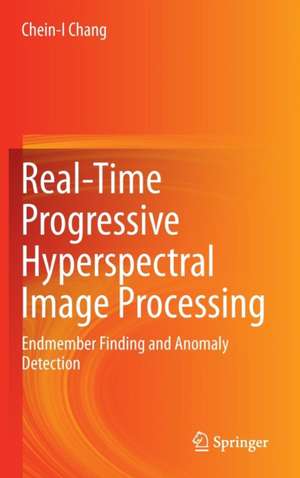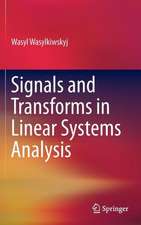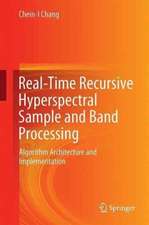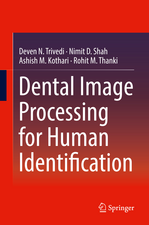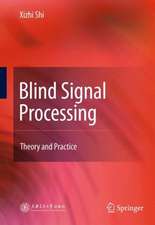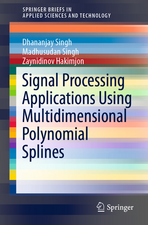Real-Time Progressive Hyperspectral Image Processing: Endmember Finding and Anomaly Detection
Autor Chein-I Changen Limba Engleză Hardback – 23 mar 2016
| Toate formatele și edițiile | Preț | Express |
|---|---|---|
| Paperback (1) | 797.87 lei 6-8 săpt. | |
| Springer – 24 apr 2018 | 797.87 lei 6-8 săpt. | |
| Hardback (1) | 913.11 lei 6-8 săpt. | |
| Springer – 23 mar 2016 | 913.11 lei 6-8 săpt. |
Preț: 913.11 lei
Preț vechi: 1113.56 lei
-18% Nou
Puncte Express: 1370
Preț estimativ în valută:
174.75€ • 181.76$ • 144.26£
174.75€ • 181.76$ • 144.26£
Carte tipărită la comandă
Livrare economică 14-28 aprilie
Preluare comenzi: 021 569.72.76
Specificații
ISBN-13: 9781441961860
ISBN-10: 1441961860
Pagini: 490
Ilustrații: XXIII, 623 p. 331 illus., 256 illus. in color.
Dimensiuni: 155 x 235 x 35 mm
Greutate: 1.08 kg
Ediția:1st ed. 2016
Editura: Springer
Colecția Springer
Locul publicării:New York, NY, United States
ISBN-10: 1441961860
Pagini: 490
Ilustrații: XXIII, 623 p. 331 illus., 256 illus. in color.
Dimensiuni: 155 x 235 x 35 mm
Greutate: 1.08 kg
Ediția:1st ed. 2016
Editura: Springer
Colecția Springer
Locul publicării:New York, NY, United States
Public țintă
ResearchCuprins
Overview and Introduction.- Part I: Preliminaries.- Linear Spectral Mixture Analysis.- Finding Endmembers in Hyperspectral Imagery.- Linear Spectral Unmixing with Three Criteria, Least Squares Error, Simplex Volume and Orthogonal Projection.- Hyperspectral Target Detection.- Part II: Sample-wise Sequential Processes for Finding Endmembers.- Abundance-Unconstrained Sequential Endmember Finding Algorithms: Orthogonal Projection.- Fully Abundance-Constrained Sequential Endmember Finding Algorithms: Simplex Volume Analysis.- Partially Abundance Non-Negativity-Constrained Endmember Finding Algorithms: Convex Cone Volume Analysis.- Fully Abundance-Constrained Sequential Linear Spectral Mixture Analysis for Finding Endmembers.- Part III: Sample-Wise Progressive Processes for Finding Endmembers.- Abundance-Unconstrained Progressive Endmember Finding Algorithms: Orthogonal Projection.- Fully Abundance-Unconstrained Progressive Endmember Finding Algorithms: Simplex Volume Analysis.- Partially Abundance Non-Negativity-Constrained Progressive Endmember Finding Algorithms: Convex Cone Volume Analysis.- Sully Abundance-Constrained Progressive Linear Spectral Mixture Analysis for Finding Endmembers.- Part IV: Sample-Wise Progressive Unsupervised Target Detection.- Progressive Anomaly Detection.- Progressive Adaptive Anomaly Detection.- Progressive Window-Based Anomaly Detection.- Progressive Subpixel Target Detectio n and Classification.
Notă biografică
Chein-I Chang is a Professor with the Department of Computer Science and Electrical Engineering at the University of Maryland, Baltimore County. His Remote Sensing Signal and Image Processing Laboratory (RSSIPL) conducts research in designing and developing signal processing algorithms for multispectral and hyperspectral imaging, medical imaging.
Dr. Chang has published over 150 referred journal articles, including more than 50 papers in the IEEE Transaction on Geoscience and Remote Sensing alone and four patents with several pending on hyperspectral image processing. He authored two books, Hyperspectral Imaging: Techniques for Spectral Detection and Classification (Kluwer Academic Publishers, 2003) and Hyperspectral Data Processing: Algorithm Design and Analysis (Wiley, 2013). He also edited two books, Recent Advances in Hyperspectral Signal and Image Processing (Trasworld Research Network, India, 2006) and Hyperspectral Data Exploitation: Theory and Applications (John Wiley & Sons, 2007) and co-edited, with A. Plaza, a book on High Performance Computing in Remote Sensing (CRC Press, 2007).
Dr. Chang has received his Ph.D. in Electrical Engineering from University of Maryland, College Park, Maryland. He is a Fellow of IEEE and SPIE with contributions to hyperspectral image processing.
Textul de pe ultima copertă
The book covers the most crucial parts of real-time hyperspectral image processing: causality and real-time capability. Recently, two new concepts of real time hyperspectral image processing, Progressive Hyperspectral Imaging (PHSI) and Recursive Hyperspectral Imaging (RHSI). Both of these can be used to design algorithms and also form an integral part of real time hyperpsectral image processing. This book focuses on progressive nature in algorithms on their real-time and causal processing implementation in two major applications, endmember finding and anomaly detection, both of which are fundamental tasks in hyperspectral imaging but generally not encountered in multispectral imaging. This book is written to particularly address PHSI in real time processing, while a book, Recursive Hyperspectral Sample and Band Processing: Algorithm Architecture and Implementation (Springer 2016) can be considered as its companion book.
- Includes preliminary background which is essential to those who work in hyperspectral imaging area
- Develops sequential and progressive algorithms for finding endmembers as they relate to real time hyperspectral image processing
- Designs algorithms for anomaly detection from causality and real time perspectives and investigates the effects of causality and real-time processing in anomaly detection
Caracteristici
Includes preliminary background which is essential to those who work in hyperspectral imaging area Develops sequential and progressive algorithms for finding endmembers as they relate to real time hyperspectral image processing Designs algorithms for anomaly detection from causality and real time perspectives and investigates the effects of causality and real-time processing in anomaly detection Includes supplementary material: sn.pub/extras
